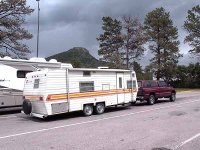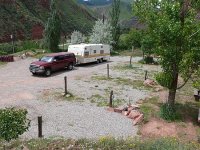...this rant is directed at the RV manufacturing industry, because so much of what you read on these forums indicates that knowledge of this type of arcane minutiae is required in order to "enjoy the RV lifestyle".
...if I'm told in advertising that I'm using 6,000 lb axles, I don't expect a ration of BS because the "fine print" says it's really 5,200.
I know . . .
Our first travel trailer was an old beat up 1978 Coachman Cadet 24-footer . . .


I never knew how much it weighed . . . didn't really care.
Nothing worked in it except the electricity and the furnace (which we only used once during the almost 15 years we owned it).
And the trailer brakes only worked going up hill . . . not down hill when you need them the most out here in the Rockies.



It was the ugliest trailer in our neighborhood . . . body pieces (plastic fenders) peeling off in the strong wind storms we get out here in the wild wild west, and all covered with hail dings.
But it was ours and it was paid off!
It had no-name brand off-road truck tires on it when we bought it . . . and they were still on it when we traded it in almost 15 years later!
We never worried about axles . . . repacked the wheel bearings once (3 years after we bought it).
I checked the tires once at the beginning of the season and maybe once in the middle of the camping season, and they rarely, if ever, needed to be topped off.
I didn't know any better, so I drove 80 MPH to get to our camping destinations.
I pulled that thing all over the state of Colorado and a couple of times to Taos, NM and never worried about a thing.
Never once did we have it in the shop (except the trailer hitch shop, of course).
In many ways I miss that old beast . . . but I really don't want it back.
However, today it seems that any time I get a strange random thought flow through my pea brain (or heaven forbid I go 66 MPH), I need to pull over and check all of the tires for air pressure and tread separation . . . crawl under the trailer to make sure the coroplast isn't peeling off or water leaks . . . inspect the axles for hardware falling off and flat springs causing the trailer to ride on the tires (yes, had that happen with our last trailer) . . . have the wheel bearings packed every time I turn around . . . retorque every nut and bolt I can reach . . . the list goes on and on!
I guess the bottom line is this . . . they just don't make them like they used to.




